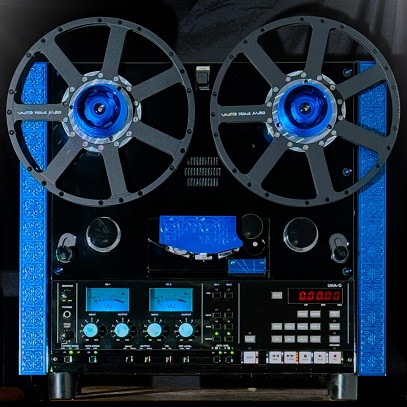Analog Audio TP-1000 Open-Reel Tape Deck
REVIEW by TAS Staff, Aug 16, 2024

Well, after admitting that I’ve overlooked French high-end audio for most of my reviewing career (see my JMF Audio review in the last issue), here I am back in France again—this time in a little commune called Pleumeur-Bodou in the Côtes-d’Armor department of Brittany, just a few kilometers from the English Channel. It was in Pleumeur-Bodou that Christophe Martinez—an engineer who’d spent 25 years developing flight-simulator electronics before going to work for Mulann RTM, a huge French conglomerate that, among many other things, manufactures magnetic recording tape—devoted four years of his life to designing and building the brand-new Analog Audio Design TP-1000 two-track, quarter-inch, 15ips/7½ips, reel-to-reel tape deck that I’m about to review.
Why would Christophe (or anyone, for that matter) spend almost half a decade engineering a brand-new reel-to-reel tape player in today’s (mostly) digital-audio world? According to Dave Denyer’s 2021 interview with Martinez in The Reel-to-Reel Rambler (a terrific site, BTW), the answer is sheer sonic delight: “I discovered the joys of analog sound while working at Mulann. During my time there I participated in the industrialization of the Kerwax Replica, a high-end tube line preamplifier. The Replica was designed at Kerwax Analog Recording Studios in Brittany, France, and was manufactured by Recording The Masters [the subdivision of RPM that makes R2R tape]…During my various visits to Kerwax I had the opportunity to listen to lots of audio tapes, an experience that left me with the conviction that it was absolutely necessary to enable as many people as possible to discover this amazing sound! So, when I left Mulann in 2017 and had some free time, I saw it as an opportunity to challenge myself to design a new tape machine. What excited me was the opportunity to explore how to use today’s technology to improve on the already excellent sound quality of tape. [thereeltoreelrambler.com/2021/12/01/analog-audio-design-now-taking-orders-for-new-tp-1000-tape-deck/].”
After considerable research, Christophe began his work in—where else?—his garage, which he turned into a kind of laboratory wherein he designed and built everything from scratch, except for the DC reel motors (sourced from the Swiss company Maxon), the capstan servo-motor, and the tape heads (from AM Belgium—the same heads that are in the Studer A800, A810, A812, and A820). On his own, Martinez developed the deck’s physical design and layout, the eq and gain electronics, the tape playback and wind/rewind path (including the “strain-gauge” tape-tension sensors that maintain tape tension at 0.5gm and read and correct errors in less than a millisecond), and the unique, built-in, multi-function touchscreen that is rather like the brain of the tape deck (more on this in a moment).
As is the case with virtually every consumer deck I know of, the TP-1000 comes with an array of pushbuttons on its front panel for forward, rewind, play, and stop. (It is a playback-only deck, so there is no record button). But, functionally, that’s where its resemblance to most present-day competitors ends. The TP-1000 and its touchscreen operating pad are loaded with remarkable convenience features. For example, via a tap on the screen (or the TP-1000’s optional remote control), you can activate a REW + Play function that rewinds the tape then starts playback immediately after rewind is completed, with automatic slowing down and stopping just before the end and the beginning of the tape so that the leader doesn’t come off the reel and need to be rethreaded. (This is ideal for pre-recorded 15ips tapes that are stored “tails out”—i.e., backwards—as almost all of them are.) Another press on the touchscreen’s LOC (Locator) “button” sets markers to which the player can automatically return, allowing you to go directly to favorite tracks just as you would with an LP, CD/SACD, or stream. You can also set rewind speed (three are available), choose equalization (NAB or IEC), adjust input and output levels, set playback fluxivity levels to 320 or 514nWB/m (optimizing playback of certain high-fluxivity Horch House and UltraAnalogue tapes), switch between 15ips and 7½ips playback speeds, change reel size, calculate tape and tape-core diameter, and adjust a slew of other parameters. All this adds up to a level of utility and convenience that makes the TP-1000 one of the most thoughtfully designed tape machines I’ve come across.

Of course, none of this ergonomic excellence would matter if the TP-1000 didn’t sound great, which, I’m happy to report, it does. Like DACs and record players, tape decks share certain sonic qualities that make the type of source they are reproducing instantly recognizable. All tapes and tape machines have these things in common: a smooth, highly lifelike continuity of sound—not just in the soundstaging sense of the words but also in the reproduction of the dynamic/harmonic envelope. In addition, they have a highly musical tonal balance that nearly duplicates the AES’ recommendation for loudspeaker voicing (i.e., an extended, somewhat elevated bass and lower midrange and a slightly rolled-off upper midrange and treble, rather as if the bottom half of a Fletcher-Munson loudness-compensation circuit were built into the tape and the deck reproducing it). Indeed, tape decks sound and image rather in the same way that MBL’s superb omnipole flagships, the 101 X-Treme MKIIs, and certain select dipoles do—they don’t break things down into microphonically isolate parts but rather pull them together into almost-visible, fully three-dimensional, sonically “complete” wholes within a large, seamless ambient soundfield. While LPs share this holistic presentation, they typically aren’t as continuous, dimensional, and easy-on-the-ears as really good tapes are (unless you’re using a DS Audio optical cartridge).
Where tape decks chiefly differ one from another is in overall neutrality, density of timbre, resolution of musical and performance detail, transient speed, dynamic range, duration (or PRaT), and susceptibility to noise (both physical and electrical). Like every deck I’ve reviewed, the TP-1000 has its own set of nuances. In balance, it is on the bottom-up side of neutral (which I prefer), which is to say it is slightly dark sounding; in bass and midrange timbre, it is uniformly dense and rich in color; in the treble, it is edgelessly soft, sweet, and a bit rolled-off without wholly sacrificing lifelike sparkle and detail; in resolution (by which I mean its ability to separate holistic images within ensembles), it is superb; its transient speed and dynamic range are also very good; it handles durations realistically, without accenting attack, steady-state tone, or decay, making for steady, foot-tapping musical pace; and thanks, one supposes, to its sophisticated, strain-gauge-regulated tape path it is dead quiet and uncommonly fluid from start to finish (where certain other machines can be a bit noisy and hurky-jerky, slightly slowing down or accelerating tape speed with consequent deleterious effects on pitch).
What do these strengths and nuances add up to in playback? Let me give you some examples.
Back in 1968, I heard Janis Joplin and Big Brother & The Holding Company sing in a superb venue, Cincinnati’s (then-undoctored) Music Hall. It was one of the two most thrilling pop concerts I’ve attended in a lifetime of concert-going. (The other was Sinatra and his big band at the same venue in the early 1990s.) Unfortunately, Columbia’s initial LP release of Cheap Thrills (the songs that Janis and her band performed on the night I heard them) left a good deal to be desired sonically. Happily, thanks to my good buddy and tape maven Greg Beron (whose new UHA Apollo is, IMO, the best-by-far Ultima deck he’s built [review forthcoming]), I have a dub of the mastertape from which the LP was made—and, as is often the case with good tape transfers, it is revelatory.
Where the LP was coarse, thin, grainy, and bass-shy, the tape is gloriously rich, full, and powerful. Each instrument (and the sometimes clumsy fingers and hands playing them) is presented as a three-dimensional whole within an ensemble of other holistic, three-dimensional instruments rather than as a collection of microphonically accentuated parts (a screechy starting transient here, a brief, thinned-down flicker of timbre there, a potted-in echo in the background), with considerably more power, extension, individuation, and clarity in the bass range than you got on the LP. (The tape is also revealing in a more mundane sense—through the TP-1000 it is quite clear why Joplin was dissatisfied with Big Brother, whose ensemble is often ragged and whose playing, particularly James Gurley’s guitar and Dave Getz’s drums, somewhat sloppy).
Was the tape identical to that long-ago concert? Well, it certainly thrilled me (and not cheaply) in the same way that the concert did, but, no, the sound wasn’t identical. The differences in acoustics, mics, performance, listening distance were plain, even 50 years later. But where the tape and concert were alike was in what Mercury Records used to call “living presence.” The concert was, of course, the thing itself, but thanks to what I’ve called completeness and continuousness—the two qualities which help create the aural and visual impression that you’re listening to and nearly seeing actual musicians playing actual instruments in an actual concert hall or studio, rather than just playing back a recording—the Cheap Thrills tape and the TP-1000 came close to delivering a convincing sense of “being there” (albeit a different “there” than Cincinnati’s Music Hall in 1968). This lifelike pre-sence is the magic of tape (and of analog, in general).
I wasn’t surprised by the improvement in the bass on Cheap Thrills. The deck’s outstanding bass range was the first thing I noted about the TP-1000. That said, and in spite of tape’s inherently rich, inherently elevated low end, some tape players (just like some phonographs and DACs) can sound a bit reticent in the very bottom octaves. The TP-1000 is not one of these. Through it, you will get true 30Hz extension on tapes that have 30Hz notes—and on exceptionally deep-reaching instruments, you’ll hear pitches (or air movements) even lower that that.
For example, I listened to Volker Lange’s new Horch House R2R release of the Swiss band Yello’s 1985 synth-pop hit album Stella. Today, synth-pop groups can be found everywhere; this wasn’t the case in ’85, when Yello was one of the pioneers of electronica (and sampling). Though not as powerfully deep-reaching as the scary, through-the-floor, room-shaking, sub-20Hz bottom end of, say, Drake’s “Hold On, We’re Going Home” from Nothing Was the Same [Young Money/Cash Money], Boris Blank’s ARP Odyssey synthesizer and Linn M-1 and Ober-heim DMX drum machines on “Oh Yeah” and other cuts go plenty low, making for a rip-tide bottom end that veers very near the 20–30Hz octave.
The same held true for the big 40Hz bass drum, harp, brasses, and massed double basses on Chabrier’s España from Chasing The Dragon’s R2R tape España. Though the Dragon live-performance recording is about as far from the studio-built Yello album as you can get (and the Dragon’s National Symphony Orchestra isn’t the London Symphony under Argenta at Kingsway Hall), both albums were recorded, mastered, and mixed entirely analog, and both sound terrific. (I’ve read where Yello’s Boris Blank intended to have Stella mixed and mastered digitally, but after hearing what digital processing did to the sound, he canceled the sessions. Even though Yello’s instruments were almost entirely electronic, Blank thought the lifeless “perfection” of digital mixing and mastering made the songs “lose their soul.”)
In the midrange, as in the bass, the TP-1000 is capable of conjuring almost-visible semblances of musicians like mezzo-soprano Rosie Middleton, who sings the “Habanera” and “The Gypsy Song” from Bizet’s Carmen on Chasing the Dragon’s España tape. (Though Middleton is no Victoria de Los Ángeles and conductor Debbie Wiseman no Sir Thomas Beecham, both do an adequate job—and the sound they make, minus an occasional bit of room boom on the bass drum, is superb.) Ditto for Janis’ incomparable, husky, explosive mezzo on Cheap Thrills or Dieter Meier’s amusingly processed basso on “Oh Yeah.”
In the treble, the TP-1000 (like all tape decks) is, as noted, beguilingly soft and sweet—far more consistently gemütlich than the top ends of CD/SACDs, digital streams, or typical LPs. Indeed, the common reviewer complaint that the treble is too bright on today’s recordings (due to close miking and hot tweeters) can be almost wholly ameliorated by listening to tape on a machine like the TP-1000. Cymbals, bells, piccolos, upper-octave violins, etc. are far more listenable (e.g., the harp, strings, and winds on España or the ride and crash cymbals on Cheap Thrills) without loss of color or shimmer.
Bottom line? This is a wonderful tape deck—outstandingly convenient, beautifully made, and both highly musical and highly realistic sounding on well-recorded R2R tapes. As today’s newly designed and completely refurbished tape decks go, it is also a sensational bargain. At $27,000, the TP-1000 isn’t cheap, but it’s a whole lot less than the decks it competes with (and outdoes when it comes to useful features). Obviously, it gets my highest recommendation. If you haven’t tried a reel-to-reel tape deck yet (and you can afford the entry fee and considerable ongoing cost of 15ips tapes), this is one you shouldn’t pass by if the absolute sound at a more affordable price is your goal.
Specs & Pricing
Electrical
Power supply: IEC 3-pole connector
Voltage range: 90 to 264 VAC
Line frequency: 47 to 63Hz
Input 1: XLR, level selectable; balanced: +4dBu (in CAL), unbalanced: –10dBV (in CAL)
Input 2: XLR (powered 48V), level selectable: -60dBV (in CAL), –40dBV (in CAL)
Output: XLR, level selectable: balanced: +4dBu (in CAL), unbalanced: -10dBV (in CAL)
Headphone output:1.5W maximum (8-ohm load)
Ethernet: RJ45 10/100Base-T for remote control and firmware update
IR input: Infrared remote control
Audio
Equalization: NAB or IEC, switchable
Reproduce record level: 320nWb/m or 514nWb/m, switchable
Frequency response: 15ips = 30Hz to 22kHz (±2dB) at 0 VU, 7.5 ips = 30Hz to 20kHz (±2dB) at 0 VU
SNR ratio: (THD-N, in CAL)/A-Weighting/15ips = 71dB/78dB, 7.5ips = 70dB/77dB
Distortion: <0.8% at 1kHz/15ips
Channel crosstalk: >60dB
Mechanical
Tape: 1/4 inch (6.35mm)
Track format: 2-track. 2-channel (DIN 0.106 inch, 2.7mm)
Max. reel size: 11.8 inch (30 cm)
Tape speed: Switchable 15ips (38.1cm/s) and 7.5ips (19.05cm/s)
Tape speed accuracy: Within +/-0.05%
Pitch control range: +/-100%, resolution of 0.01ips
Wow and flutter: 15ips = <0.045% peak, weighted (DIN 45507); 7.5ips = <0.09% peak, weighted (DIN 45507)
Wind speed: switchable 2m/s, 6m/s,10m/s
Wind speed control: 1m/s to 12m/s, resolution of 1m/s
Capstan motor: DC servo motor, belt-drive
Reel motor: 2x DC motor, belt-drive
Dimensions: 466mm x 519mm x 305mm
Weight: 61.73 lbs. (28 kg)
Price: $27,000
ANALOG AUDIO DESIGN
48 Bis Route de Trébeurden
22560 Pleumeur-Bodou, France
analogaudiodesign.com
+33 6 64 93 83 84




